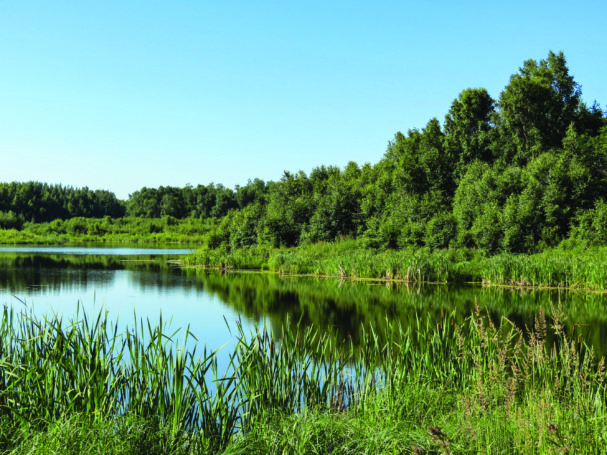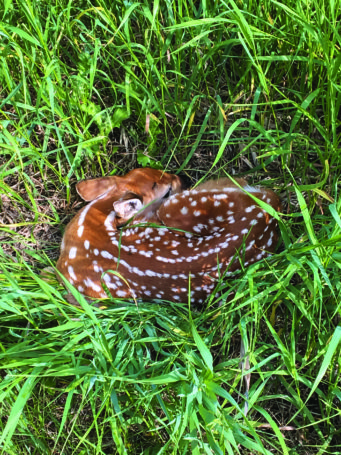September 6, 2018
The Edmonton and Area Land Trust’s conservation lands are beautiful sanctuaries you may have never even heard about, let alone seen
No matter how much you love the city, it makes you dirty. You can see it on the bottoms of your shoes, and if you’re a barefoot strider your soles will gum-grit-and-grime after just a block or two. But that pollution doesn’t stop at your skin. There’s the smog that gets inside your body from all those cars and our annual western forest fires. And it goes past your lungs and inside your skull with the never-ending noise of traffic and commerce, and the never-ending pressures of work, family and global crises. So how can you escape it? How can you cleanse your body and your mind?
There’s a path to purifying yourself. Anyone can take it, nearly any day of the year, and while it’s highly addictive, it’s completely good for you, it’s free and it’s easy. It’s Edmonton’s best-kept soul-saving secret: one giant serpentine path and 12 sparkling sanctuaries. Simply enter it to indulge in shinrin-yoku, Japanese for “forest bathing.”
No, you don’t need to take off your clothes, and you won’t get sprayed with water. Just wander in the green to lose yourself in order to find yourself.
The serpentine path is the North Saskatchewan River Valley (three times bigger than Vancouver’s Stanley Park and 22 times bigger than New York’s Central Park); the 12 sanctuaries are the stunning treasure of the prosaically named Edmonton and Area Land Trust.
The EALT, stewards of a series of donated emerald conservation lands inside and mostly outside city limits, is celebrating its first decade of existence, this year. While EALT’s name won’t win any poetry prizes, the names of the individual preserves might, including Glory Hills, Bunchberry Meadows, Ministik and Golden Ranches. They comprise a conservation network whose healing powers rival any therapist’s couch or pharmacist’s counter. As long ago as 2001, the American Psychological Association published its finding that “Green is good for you.” Tests showed that 40 minutes of walking in green areas (as opposed to walking city streets, quiet reading or listening to music) decreased anger, increased pleasant emotions and improved concentration. As the APA reported, “children who live in greener environments have greater capacity for paying attention [and are] better able to delay gratification and inhibit impulses.”

In mid-June, I took my two daughters, ages 11 and 8, to see the Larch Sanctuary, the only EALT reserve inside city limits. Located in the southerly Whitemud Creek ravine between Century Park and Rabbit Hill Road, the 24-hectare sanctuary is accessible via the south side of the overpass on 23rd Avenue or via footpaths from its bordering neighbourhoods.
Within a few minutes of us walking, the tinnitus of traffic faded to zero, and it was hard to remember we were inside a greater metro area of a million people. I asked my delighted daughters to describe what we were seeing as we saw it. Big Girl said, “There’s a lot of trees, purple flowers, yellow flowers, and oh! There’s a birdy! A duck! There’s a blue, metal, rustic bridge!” Little Girl added, “We’re looking at where the two small creeks join into a small river, and lots of small rocks!” Spotting a watercourse or maybe a culvert I hadn’t seen, Big Girl noted, “There’s also a secret tunnel . . . maybe Batman goes [into the Bat Cave] there!”
As we rose and fell with the landscape, we finally reached a clearing where the Whitemud Creek silently anticipated intermingling, downstream, with its Blackmud soulmate. Despite its name, the Whitemud at times resembled chocolate milk, reminding me of Milk River on Alberta’s southern border. But you don’t need to drive eight hours to encounter wildlife; the Larch Sanctuary provides home for woodpeckers, coyotes, foxes, deer, and even moose. We also saw a birdhouse-sized “bee hotel,” a human-made housing project for any of Alberta’s 300 native species of non-hiving bees that don’t make honey but pollinate crops, fruits and vegetables that are a third of our diet.
So, who banded together to protect such a beautiful area inside our city, and why? “There was a clear decrease in natural areas — 16 per cent per year from the early 1990s were being lost,” says Pamela Wight, the executive director of the EALT.
The city and environmental groups were concerned, she said, and asked Edmontonians if the solution might be a land trust. The public agreed on the need, but wanted any trust to be arm’s-length, free from the changing political winds of municipal elections. The result was the non-profit Edmonton and Area Land Trust, which includes as founding members the philanthropic Edmonton Community Foundation, the City of Edmonton and the Urban Development Institute, as well as environmental groups. Its goal was to preserve ecologically significant Alberta Capital Region lands.
“We need to keep our natural areas,” says Wight. “Citizens enjoy being there. The need was clear.”
By 2010, the EALT had acquired natural areas at Golden Ranches and Glory Hills, joined by Ministik in 2011 and Pipestone Creek in 2012. That year, a private sector partner planted more than 30,000 trees, and by 2013 added a quarter of a million tree seedlings. Since then, the EALT has completed many major projects to steward its lands, making habitats safer for wildlife, adding nest boxes for cavity-nesting species, and removing invasive plants.

EALT is also very engaged in outreach: it’s added its interpretive Go Wild for Geocaching program; convened bee hotel workshops and erected numerous bee hotels on public and private land around Edmonton, to cultivate solitary bee habitat and generate awareness of the importance of pollinators; and conserved 30 hectares of the Smith Homestead in the Beaverhills International Biosphere Reserve and 300 hectares of Parkland County’s environmentally sensitive Devon Dunes habitat. With 12 conservation zones now under its protection, the EALT also partners with students and elders at amiskwaciy Academy and MacEwan University’s Aboriginal Studies program to work on Cree names for some of the land trust’s conservational preserves.
As my daughters and I continued joyfully navigating the Larch Sanctuary, I couldn’t help but think of that small chorus crying to colonize our magnificent wild spaces — whether inside the ravine we were exploring, or in the vast North Saskatchewan River Valley itself — with chain-store coffee shops and bars to drink away the think (as if Edmonton didn’t already have enough of those). But if more people could simply experience the wonder of our land trust’s natural areas, they’d know they don’t need beer or Starbucks to enjoy the glory of the green. They just need to breathe. And listen. And walk. By preserving this econetwork for future generations, the EALT is maintaining walls of sentinel trees, a protective habitat for herds of proud deer and legions of hyper-productive bees, and a living heart of jade that science proves energizes and purifies our individual and collective bodies and minds.
A brief timeline of the Edmonton and Area Land Trust’s first 10 years:
2009
Secures Hicks property (in Strathcona County, south of Hastings Lake)
2010
Secures Golden Ranches (adjacent to Cooking Lake) and Glory Hills (north of Stony Plain)
2011
Secures Ministik (in Camrose County)
2012
Secures Pipestone Creek (east of Wetaskiwin)
Partners with a private company to plant 30,000 trees on EALT lands
2013
Wins an Alberta Emerald Award for environmental excellence
Publishes the first Guide to Species at Risk in Alberta
Plants another 250,000 trees on EALT lands
2014
Secures Boisvert’s GreenWoods (north of Morinville)
2015
Secures Coates (north of Calmar)
Launches Go Wild for Geocaching and Protecting Pollinators programs
2016
Publishes Species at Risk in Alberta Children’s Activity Booklet
Secures Bunchberry Meadows (south of Enoch Cree Nation) *
Publishes Nature’s Nourishment Recipe Book, featuring native plants
2017
Secures Larch Sanctuary (first property within city of Edmonton)
Secures Lu Carbyn Nature Sanctuary (in Lac St. Anne County)
Launches the EALT Kids program, with Discover Nature Kits, resources, and website
2018
Partners with amiskwaciy Academy to develop Cree names for select properties
Secures Devon Dunes, a sensitive habitat in Parkland County
Secures the Smith Homestead in the Beaverhill International Biosphere Reserve